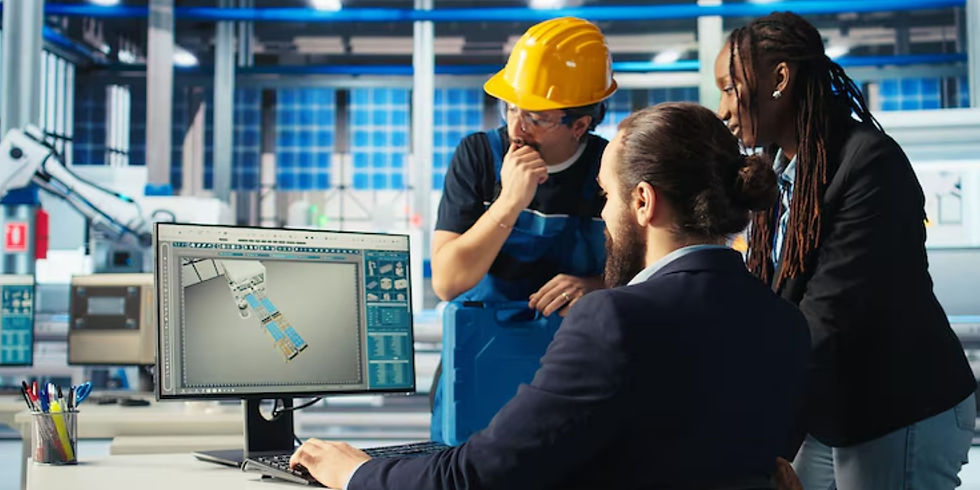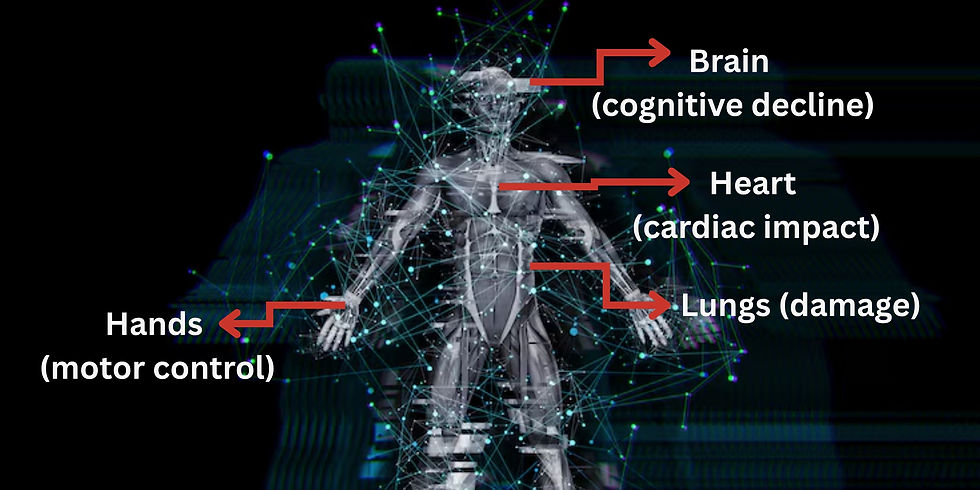Quality Welding Supplies: Beyond the 2025 Air Quality Standards
- Tania Ford
- May 14
- 7 min read
Updated: Aug 4

Did you know that 83% of Australian welding workshops that passed their 2023 compliance inspections will still fail under the 2025 standards? When welding stainless steel or galvanised metals, harmful substances like hexavalent chromium, manganese, and nickel are released into the air—and if your quality welding supplies aren't doing their job, those toxins are going straight into your workers' lungs and bloodstream. The uncomfortable truth: most extraction systems installed before 2023 capture less than 40% of actual fume particles generated during arc-on time.
With Australia's updated 2025 air quality standards now in full force, the rules of the game have changed—and the penalties for falling short are steep. Permissible exposure limits for welding fumes have been slashed by nearly 80%, meaning older extraction systems may no longer be compliant. Fines for non-compliance now reach $15,000 per day, but the real cost is the long-term damage to your workforce's health.
I never thought I'd become "that safety guy" at our fabrication shop, but after seeing three mates develop respiratory issues over just two years, I couldn't ignore the invisible threat any longer. That's why I've spent the last six months testing and implementing upgraded fume extraction system solutions—and what I found might surprise even veteran welders. And remember, quality welding supplies aren't just about machines—they're about strategic investments that protect both your team and your bottom line.
Understanding the 2025 Air Quality Standards
While most welding professionals are familiar with the headline changes in the 2025 standards, few understand the technical nuances that will impact compliance strategies. This section covers what other guides don't tell you.
Key Regulatory Changes: The Fine Print That Matters
Reduced exposure limits: Workplace exposure standards for welding fumes have decreased from 5mg/m³ to just 1mg/m³ (time-weighted average over 8 hours)
Specific metal compound limits: Manganese compounds reduced from 1mg/m³ to 0.2mg/m³
Carcinogen classification: All welding fumes now classified as "known carcinogens" rather than "probable carcinogens"
Mandatory real-time monitoring: Operations exceeding 50 total welding hours weekly must implement continuous air quality monitoring
Documentation requirements: Detailed records of exposure assessments must be maintained for 30 years (previously 7 years)
State-by-State Enforcement Variations
What your industry peers don't realise is that enforcement priorities vary significantly across Australia:
State | Inspection Trigger | Focus Area | Unique Requirement |
NSW | Annual license renewal | Documentation systems | Real-time monitoring data retention |
Victoria | Random + complaint-based | Engineering controls | Third-party verification of systems |
Queensland | Industry sweeps | Worker training | Bi-annual medical surveillance |
Western Australia | Follow resource sector schedule | Remote operations protocols | Specific FIFO requirements |
South Australia | Post-installation certification | Filter efficiency standards | Reporting to SA Health |

The Compliance Deadline Matrix
Unlike previous regulatory changes, the 2025 standards implementation follows this critical timeline that most shops haven't properly planned for:
The Hidden Health Risks Data: What Your Workers Aren't Telling You
The published literature on welding fume health impacts only tells part of the story. Recent findings from the Australian Centre for Occupational Health reveal more concerning trends than previously understood.
The Latest Research Findings on Exposure Impact
New Australian study results that haven't made it into most industry publications:
Cognitive function decreases measurably after just 3 years of moderate fume exposure
Manganese exposure affects fine motor control before obvious symptoms appear
Welders with inadequate extraction show reduced lung capacity of 7-12% compared to properly protected workers
Cardiac impacts now linked to ultrafine particulate exposure during welding
Early Detection Systems
Traditional air quality monitoring only tells part of the story. These advanced detection approaches provide earlier warning signs of potential issues:
Biological monitoring markers: Simple blood tests can detect early manganese accumulation before neurological symptoms develop
Cognitive assessment tools: Digital applications that can detect subtle cognitive changes related to fume exposure
Spirometry trending: Tracking minor lung function changes over time provides early warning of developing issues
The Numbers Behind the Case Studies
Case Study: Brisbane Fabrication Workshop This 12-person operation faced potential fines after inspection revealed manganese levels at 0.57mg/m³ (nearly 3x the new limit). Their $32,000 investment in a new high-vacuum welding smoke extractor system delivered:
47% reduction in worker sick days within 6 months
22% increase in productivity (measured as billable hours per shift)
$4,200 monthly labor cost savings
Complete ROI achieved in 9.2 months
Case Study: Western Australian Mining Equipment Repair This rural operation's $45,000 investment in combined source capture and ambient systems yielded:
64% reduction in total respirable particulate concentrations
Zero reportable respiratory incidents (down from 8 the previous year)
87% decrease in filter replacement costs for facility HVAC systems
Two-step improvement in workers' compensation insurance rating
Advanced Extraction System Selection Matrix
Moving beyond basic extraction categories, this section provides the technical specifications and selection criteria that equipment vendors rarely discuss openly.
The Technical Specifications That Matter Most
When evaluating extraction systems, these are the specifications that experienced welding professionals focus on:
Parameter | Industry Standard | Best-in-Class | Why It Matters |
Capture velocity | 0.5 m/s at 300mm | 0.7 m/s at 450mm | Determines effective working distance |
Static pressure | 2500 Pa | 3200+ Pa | Maintains performance with filter loading |
Filter media MERV rating | MERV 15 | MERV 16+ | Captures submicron particles |
Sound pressure level | 76 dBA | <70 dBA | Prevents user disabling due to noise |
System pressure loss monitoring | Basic indicator | Digital with logging | Identifies maintenance needs |
Next-Generation Extraction Technologies
The most innovative extraction technologies emerging in the Australian market:
Adaptive capture systems: Sensors track the arc position and automatically adjust extraction direction
Hybrid filtration media: Combined electrostatic and mechanical filtration that optimises for both efficiency and filter life
Low-voltage integration: Systems that communicate with welding power sources to activate only during actual welding
Predictive maintenance AI: Monitors system performance and predicts filter replacement needs before efficiency drops
Strategic System Selection Framework
Beyond technical specifications, this decision framework helps optimise your extraction investment:
The optimal extraction approach depends on these five key variables:
Duty cycle percentage
Material composition diversity
Workspace configuration flexibility needs
Ambient air movement factors
Process-specific fume generation rates

Implementation Action Plan: Beyond Basic Installation
Installing extraction equipment is only the starting point. This implementation framework ensures your system delivers maximum protection and return on investment.
7-Step Implementation Protocol
Follow this structured approach to extraction system implementation:
Baseline assessment
Conduct full-shift personal and area monitoring
Document current exposure levels by process and location
Create exposure map of your facility
System engineering review
Professional airflow study and computational fluid dynamics modeling
Cross-draft identification and mitigation planning
Integration with existing HVAC systems
Pilot installation
Implement controls for highest-risk processes first
Establish performance benchmarks
Document lessons learned before full deployment
Full implementation
Strategic rollout sequence based on risk assessment
Minimise operational disruption through staged installation
Integrate monitoring sensors at key locations
Validation testing
Post-installation exposure monitoring
System performance verification under various operating conditions
Documentation of achieved control effectiveness
Staff training program
Proper positioning techniques for extraction equipment
Understanding system indicators and warnings
Health risk communication and protective practices
Continuous improvement cycle
Regular performance review against established KPIs
Quarterly system optimization assessments
Annual technology review and upgrade planning
Advanced Installation Techniques Most Suppliers Won't Tell You
These expert-level installation approaches can dramatically improve system performance:
Strategic airflow engineering: Position general ventilation to create slight negative pressure zones that support, rather than disrupt, local extraction
Hybrid capture strategy: Combine overhead source capture with downdraft tables for optimal capture of different fume profiles
Modular ductwork configuration: Design system to allow easy reconfiguration as production layouts change
Cross-contamination prevention: Separate stainless steel welding extraction from mild steel processes to prevent cross-contamination of more hazardous particulates
Advanced Compliance Verification and System Optimization
Moving beyond basic compliance to create a world-class air quality management system requires sophisticated monitoring and continuous optimization.
Next-Generation Air Quality Monitoring Approaches
Traditional air monitoring methods provide only snapshots in time. These advanced approaches provide continuous, actionable data:
Real-time particulate monitoring
Direct-reading instruments with data logging capabilities
Particle size differentiation (PM1, PM2.5, PM10)
Trend analysis with alert thresholds
Integration with central building management systems
Metal-specific monitoring technologies
X-ray fluorescence (XRF) analysers for specific metal identification
Targeted monitoring for hexavalent chromium and manganese
Source attribution analysis for mixed exposure environments
Personal exposure monitoring innovations
Wearable sensor technologies with Bluetooth data transmission
Exposure tracking linked to specific processes and locations
Individual exposure profiles for targeted interventions
Extraction System Performance Optimization
These optimization techniques can improve system performance by 15-30% without major capital investment:
Airflow balancing protocol
Professional testing and balancing of multi-point systems
Strategic damper placement and adjustment
Zone-specific control optimization
Energy efficiency optimization
Variable frequency drives with demand-based control
Smart scheduling based on production patterns
Heat recovery from exhaust air streams
Filter management strategy
Progressive filtration staging for extended primary filter life
Pressure differential-based replacement schedules
Filter media selection based on contaminant profile analysis
Documentation System for Bulletproof Compliance
Create a comprehensive documentation system that not only satisfies regulators but also supports continuous improvement:
Key documentation components:
Baseline exposure assessment reports
System design specifications and engineering calculations
Installation certification documentation
Regular testing and balancing reports
Worker training records with competency verification
Maintenance logs with filter replacement tracking
Exposure monitoring data with trend analysis
Health surveillance program results (anonymised)
System optimization projects and outcomes

Protecting Your Team and Business
Implementing proper fume extraction isn't just about regulatory compliance—it's an investment in your workshop's future and your team's wellbeing. With the 2025 standards now in effect, workshops across Australia face a clear choice: adapt proactively or risk significant consequences. Don't wait for an inspection or, worse, a health incident to address your workshop's air quality. The time to act is now, before the full enforcement period begins. Remember that compliance isn't just about having equipment—it's about having the right equipment, properly installed, maintained, and used. Partner with suppliers who understand not just the products but the regulatory landscape and your specific workshop needs.
In my three decades in Australian workshops, I've seen many safety trends come and go. But the focus on welding fume extraction isn't a passing phase—it's a fundamental shift in how we protect welders. The shops that embrace this change aren't just checking a regulatory box; they're building healthier, more productive workplaces that will thrive long into the future.


Comments